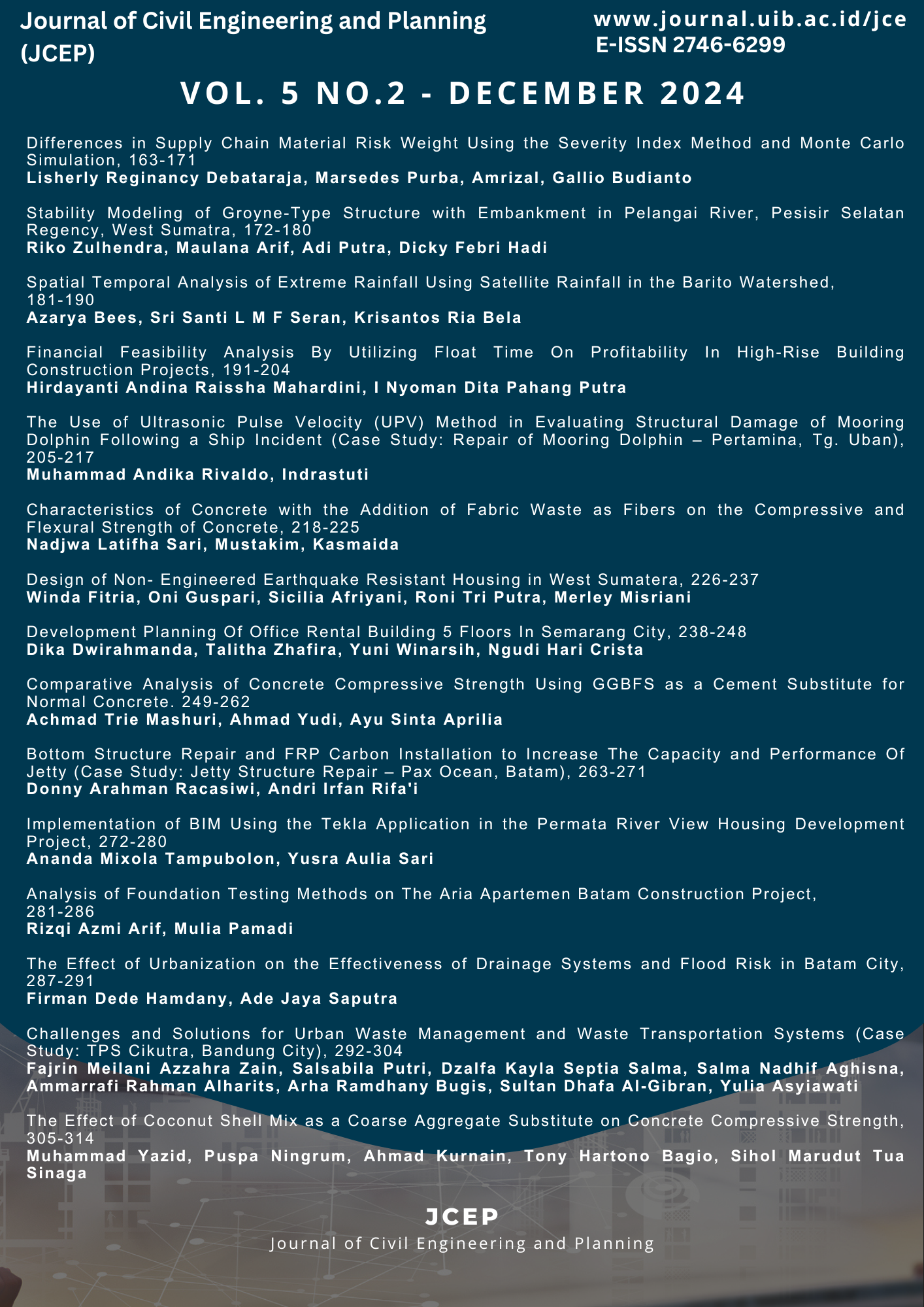Comparative Analysis of Concrete Compressive Strength Using GGBFS as a Cement Substitute for Normal Concrete
DOI:
https://doi.org/10.37253/jcep.v5i2.10046Abstract
Building constructions found in Indonesia generally use concrete as the main structural material. This research aims to analyze the use of ground granulated blast furnace slag (GGBFS) as a cement substitute in concrete mixtures using the Analysis of Variance method (Anova) and the Tukey Method. The GGBFS levels used are 0%, 25%, 30%, 35%, 40% and 45% as cement substitute. The average compressive strength values obtained for each sample were 25.08 MPa, 25.1 MPa, 25.7 MPa, 25.9 MPa, 26.4 MPa, 27.7 MPa and 26.2 respectively. MPa. The compressive strength value continues to increase with the highest compressive strength value at 40% and decreasing again at 45%. The use of ggbfs requires an activator to accelerate the mechanical properties of ggbfs itself. The activator used is NaOH with a concentration of 4 Mol.
Downloads
References
Arie Marselino Liang and Koespiadi, “Pengaruh Mutu Material Bton Terhadap Efisiensi Biaya Pembangunan Gedung Bertingkat,” 2019.
F. Faldo, M. Hudori, K. Kunci, B. Campuran, T. Beton, and S. Polypropylene, “Pengaruh Efektifitas Penggunaan Serat Polypropylene Terhadap Kuat Tekan Beton Normal,” Journal of Civil Engineering and Planning, vol. 2, no. 1, 2021.
R. Pujantara, “Struktur Beton Bertulang dalam Perspektif Struktur Beton Bertulang dalam Perspektif Fleksibilitas Bentuk dan Arsitektur Plastis pada Rancangan Dekonstruksi,” 2014.
R. P. Herdiamsyah dan Mekar, “Pengaruh Batu Cadas (Batu Trass) Sebagai Bahan Pembentuk Beton Terhadap Kuat Tekan Beton,” 2013.
PT Krakatau Semen Indonesia, “Aplikasi Material GGBFS pada Infrastruktur Ramah Lingkungan Berperforma Tinggi,” 2020.
Rano Noviana Anwar, Abdul Chalid, and Chandra Afriade Siregar, “Pengaruh Ground Granulated Blast Furnace (GGBF) Slag Sebagai Bahan Tambah Ssbagian Semen Terhadap Kuat Tekan Beton,” Bulan Maret Tahun, 2023.
B. H. Setiadji, H. Dewabrata, H. Ay Lie, and S. A. P. Subagyo, “Studi Penggunaan Semen Slag sebagai Substitusi Semen Portland pada Beton,” Siklus : Jurnal Teknik Sipil, vol. 6, no. 2, pp. 117–128, Oct. 2020, doi: 10.31849/siklus.v6i2.4595.
R. N. Arini, N. Warastuti, M. Wahyu, and K. Darmawan, “Analisis Kuat Tekan dengan Aplikasi Ground Granulated Blast Furnace Slag Sebagai Pengganti Sebagian Semen pada Campuran Beton,” 2019.
Y. Setyaning Astutik, “Studi Komparatif Kerusakan Beton pada Struktur Kolom yang Keropos dengan Metode Grouting,” 2020.
BSN, “SNI 1974:2011 Cara Uji Kuat Tekan Beton dengan Benda Uji Silinder,” 2011, [Online]. Available: www.bsn.go.id
Cipta Karya, “Peraturan Beton Bertulang Indonesia,” 1971.
ASTM, “ASTM C39 Standard Test Methodfor Compressive Strength of Cylindrical Concrete Specimens,” 2018.
ASTM C127, “Standard Test Method for Density, Relative Density (Specific Gravity), and Absorption of Coarse Aggregate 1,” 2009. [Online]. Available: www.astm.org,
ASTM C128, “Standard Test Method for Density, Relative Density (Specific Gravity), and Absorption of Fine Aggregate 1,” 2009. [Online]. Available: www.astm.org,
BSN, “SNI ASTM C136:2012 Metode Uji Untuk Analisis Saringan Agregat Halus dan Agregat Kasar,” 2012. [Online]. Available: www.bsn.go.id
BSN, “SNI 03-2834-2000 Tata Cara Pembuatan Rencana Campuran Beton Normal,” 2000.
BSN, “SNI 7656:2012 Tata Cara Pemilihan Campuran Untuk Beton Normal, Beton Berat dan Beton Massa,” 2012. [Online]. Available: www.bsn.go.id
Downloads
Published
Issue
Section
License
Copyright (c) 2024 Achmad Trie Mashuri, Ahmad Yudi, Ayu Sinta Aprilia

This work is licensed under a Creative Commons Attribution 4.0 International License.



_0011.jpg)









